7 challenges & 5 solutions
The International Symposium on the Ecology and Evolution of Marine Parasites and Diseases organized by David Thieltges and Matthias Wegner has been held at
NIOZ in Texel - NL on 10-14 March 2014. Among the various topics discussed during the symposium, Robert Poulin initiated the discussion on the integration of parasitology into marine ecology.
Robert Poulin identified 7 potential challenges to come over in order to reach this goal:

1-More parasites in marine ecology
Parasites are still largely ignored in ecology despite their importance as regulators of populations (
Anderson & May 1981 PhilTransSocLB), as preys (
Johnson et al. 2010 TREE,
Goedknegt et al. 2012 eLS) and in terms of biomass (
Dobson et al. 2008 PNAS,
Kuris et al. 2008 Nature). Taking this part of biodiversity in marine biology would benefit theory.
2-More marine ecology in parasitology
Parasitologists have also typically ignored important discoveries in marine ecology that could help understanding host-parasite interactions in marine systems. Robert Poulin gave the example of ocean acidification that was emphasized in marine ecology but remained largely ignored by parasitologists in their research (
MacLeod & Poulin 2012 Trends Parasitol.).
3-Maintain parasite discovery rate
Even if many parasites are known, most of parasitic diversity remains to be discovered (the rate of discovery is still very high). This is currently accentuated with recent findings of cryptic species of parasites (e.g.
Miura et al. 2006 PNAS,
Rellstab et al. 2011 MEEGID). Discovering new species of parasites could help us estimating the importance of parasites in ecosystems and the structuring of parasite communities.
4-Elucidate parasite life-cycles
As pointed in section -3, the life-cycles of many parasites remain to be discovered: elucidating the transmission routes used by pathogens to spread within host populations is challenging and remains a central aim of epidemiology. Elucidating the life-cycles of parasites could improve the theory and help managing diseases (e.g.
Dash & Vasemägi 2014 DAO).
5-More model parasite systems
Only a few parasite species are model systems (e.g. daphnia their microsporidia parasite
Pasteuria ramosa, threespine stickleback and the tapeworm
Schistocephalus solidus, salmonids and their lices). This is very contrasting with the diversity of parasites (and of their life-cycles) and questions about the relevancy of these models to represent most parasitic organisms.
6-Go offshore and go deep
We don't know much about the diversity of parasites offshore and in the deep sea nor their role in these ecosystems and much of the research has focused so far on parasites in coastal ecosystems. Going offshore and deep would help in getting a wider view of the importance of parasite in marine systems.
7-Tweak epidemiology for the sea
The epidemiological framework has been developed for terrestrial organisms. Hence it is possible that adapting epidemiological models to marine systems (e.g. by including water thickness in dispersion parameters) could lead to different predictions than in the terrestrial environment.
Robert Poulin ended up his presentation with 5 simple solutions to these challenges:
-More parasites in marine journals
-Keep up with the key ideas of other fields
-Support taxonomy and basic life cycle research
-Study new model parasite systems
-Tweak epidemiology for the sea








